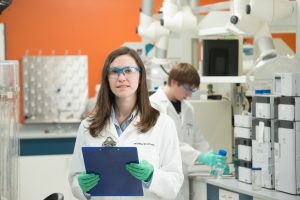 ‘Extractables and leachables’ is a broad term which encompasses the analysis for compounds which migrate out of a polymer, whether through a forced extraction process in a laboratory or during the typical product life cycle. Products which undergo extractables and leachables testing include medical devices, pharmaceutical packaging, single-use bioprocess components, food contact materials, and many other consumer goods. Liquid Chromatography-Mass Spectrometry (LC-MS) has emerged as a technique of choice for extractables and leachables testing due to its high sensitivity for trace components of a mixture and its ability to unambiguously identify these trace components.
‘Extractables and leachables’ is a broad term which encompasses the analysis for compounds which migrate out of a polymer, whether through a forced extraction process in a laboratory or during the typical product life cycle. Products which undergo extractables and leachables testing include medical devices, pharmaceutical packaging, single-use bioprocess components, food contact materials, and many other consumer goods. Liquid Chromatography-Mass Spectrometry (LC-MS) has emerged as a technique of choice for extractables and leachables testing due to its high sensitivity for trace components of a mixture and its ability to unambiguously identify these trace components.
Compounds which may be found in an extractables and leachables study include polymer additives (anti-oxidants, slip agents, light stabilizers, dyes), residual solvents and monomers, and polymer degradation products. Because these substances all present unique product safety issues, it is critical to obtain as much information as possible about the amount and identity of compounds migrating from a polymer matrix. Regulatory compliance requires extractables and leachables testing for many products. For non-regulated products, extractables and leachables testing is a good practice to ensure that high quality standards are met.
For volatile and semi-volatile compounds, Gas Chromatography-Mass Spectrometry (GC-MS) has been used to effectively separate, quantify, and identify extractables and leachables. However, non-volatile components and oligomeric degradation products are typically out of scope for GC-MS. Prior to advances in LC-MS screening, non-volatile components were analyzed using a targeted screening approach by HPLC or other methods. Such targeted methods miss many components of an extractables and leachables mixture if the compounds were not expected to be present. LC-MS can be used to analyze for non-volatiles with molecular weights ranging from about 50-4000 Daltons. An Ultra-Performance Liquid Chromatography (UPLC) column is used to separate the components of a complex extractables and leachables mixture. The separated components are then ionized and detected by mass spectrometry, assigning a mass-to-charge ratio which is dependent on the molecular weight of a compound. This method is highly sensitive. LC-MS can be used to analyze compounds at parts-per-billion (ppb) concentrations, and small sample quantities are typically used. A high-resolution accurate-mass LC-MS, such as a quadrupole time-of-flight (qTof) instrument, is especially helpful for extractables and leachables testing. The high mass accuracy of this instrument allows compounds from an extractables and leachables study to be identified with high certainty, even if the compounds were not expected to be present. A qTof instrument also can produce ion fragmentation patterns, which are used as fingerprints to give additional confidence in the identification of a compound. Power cheminformatics software is used to match parent and fragment ions, assisting in the data interpretation.
Producers of medical devices, pharmaceuticals and consumer products use the data from an extractables and leachables study to perform a risk assessment of their overall process. These industries have been transformed by a myriad of innovations in recent years. New types of materials with unique properties are being introduced continuously. Extractables and leachables testing using LC-MS will help companies keep-up with the pace of transformation to enable products which deliver on the promise of innovation.
This post was contributed by one of our amazing scientists, Dr. Eric Mertz!
